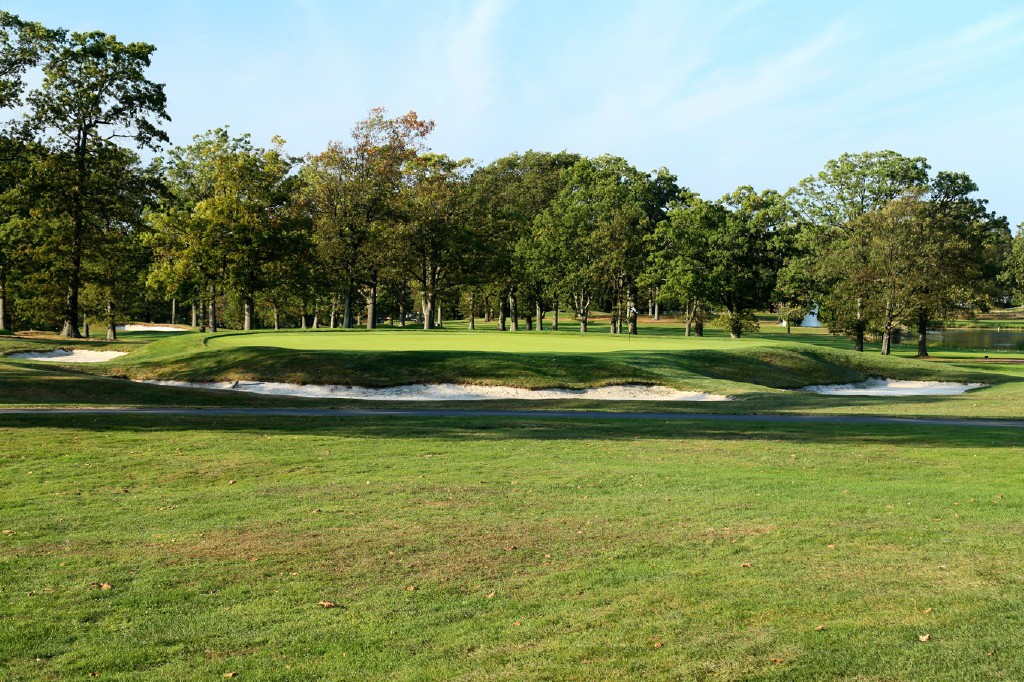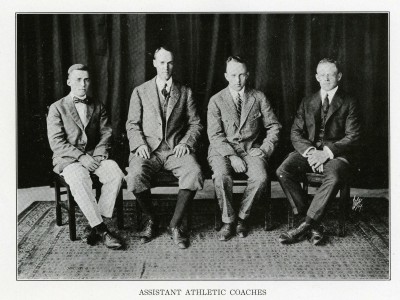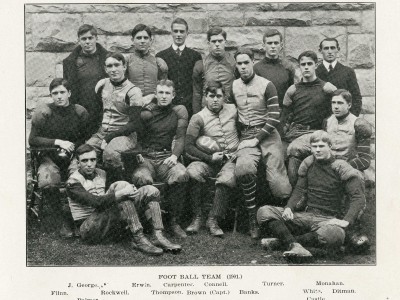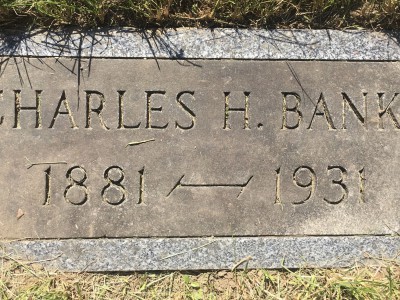By Anthony Pioppi
In the annals of golf course architecture, few careers were as brief and memorable as Charles Banks’s, while still leaving behind so many pressing questions.
A member of the Great Design Triumvirate, Banks was a protégé of Seth Raynor, who in turn was a protégé of Charles Blair Macdonald, the father of American golf course architecture. Banks’s design career began in mid-1925 and ended less than six years later in March of 1931. In that time, Banks completed some of Raynor’s most highly-regarded courses after his mentor died unexpectedly. Banks laid out approximately 20 of his own designs, most of which were built, and renovated a smattering of others, before he too passed away early, succumbing to a heart attack at the age of 49.
Banks celebrated and successful career occurred during the Golden Age of Golf Architecture when the likes of A.W. Tillinghast, Alister Mackenzie and Donald Ross were at their height.

The sixth hole at Rock Spring Golf Club in West Orange, N.J., a Seth Raynor design built by Charles Banks. (Photo by Brett Zimmerman)
Visit Banks’s courses and it is readily apparent that his style fits seamlessly in with that of Macdonald and Raynor. The concepts Macdonald and Raynor popularized are found on every one of his creations, such as Knoll, Road, Biarritz and Redan holes, which Macdonald referred to as “Ideal” holes. Like the layouts of his mentors, though, some of Banks’s best work are his own creations, built to fit a precise piece of land, having absorbed the tenants of sound design from Macdonald and Raynor.
Banks’s surviving work displays a boldness that calls to mind Macdonald more than Raynor. For instance, the prominent mounding that is part of green complexes at layouts such as Tamarack Country Club in Greenwich, Conn., Cavalier Golf and Yacht Club, in Virginia Beach and Forsgate Country Club in New Jersey.
That Banks was able to create his own niche while working within the confines of the Macdonald-Raynor motif displays a grasp of not just the strategy but also the artistry.
Like all the other designers working at the same time as him, Banks used modern mechanized equipment to move earth rather than horses and drag plates, taking advantage of the new technology. Unfortunately, somewhere along the line, a story spread that Banks lost a steam shovel in a bog, now a pond, during the construction of Whippoorwill Club in Armonk, N.Y. The tale is false. When the pond was drained a few years ago, no heavy equipment was found. Nevertheless, Banks was tagged with the ill-suited nickname “Steam Shovel” by a long-forgotten individual. My research found the first written instance occurred, 55 years after he died, in a 1986 New Jersey newspaper article.
Similar to Macdonald, but in contrast to Raynor, Banks not only designed courses, but also wrote about the craft, his work appearing in newspapers, and at least two national golf magazines.
Banks’s article in the Feb. 1 1927 issue of The Honolulu Advertiser, recounts Raynor’s final days, just over a year after his death, a rare and illuminating glimpse into Raynor’s life.

The Punchbowl green of the 11th hole at Tamarack Country Club in Greenwich, Conn., a Charles Banks design. (Photo by Brett Zimmerman)
His 1930 seven-part series for American Golfer on every aspect of building a golf course, from selecting a site to estimating the cost to utilizing topography, was one of the most in-depth explanations of the design process ever compiled up to that time, much of it as relevant today as it was nearly 90 years ago.
It is most likely that Banks and Raynor met probably somewhere in late 1924 or early 1925 when Raynor was hired to renovate the existing nine-hole course at the Hotchkiss School in the far northwest Connecticut town of Lakeville, where Banks was the head of alumni fundraising. Banks was part of the group that served as a liaison between Raynor and the school during work on the course. Banks had also graduated from Hotchkiss before attending and graduating from Yale.
The connection between Raynor and Banks, and Banks’s sudden interest in golf architecture was in full bloom by the summer of ’25 when Banks left behind his beloved Hotchkiss and joined Raynor, who immediately put him to work. Even though Raynor was also designing an 18-hole course at Yale, approximately 65 miles to the south in New Haven, Conn., Banks does not appear to be part of that job. In that same time period, there are records of him working at Deepdale, a Charles Blair Macdonald design on Long Island which Raynor was building, as well as Augusta (Ga.) Country Club.
Around the same time, Raynor also laid out a nine-hole course for the Watertown Golf Club, which was located on the campus of the Taft School, another prestigious prep school located in Northwest Connecticut. It was built without Raynor or his staff playing a role in the construction. It no longer exists.
Although Raynor had individuals who worked with him in various capacities, civil engineers and construction supervisors, for much longer than Banks, Banks was the only one he ever elevated to associate. An astounding achievement for someone who had no background in course design or civil engineering.

Charles Banks, second from left, with other assistant coaches. The photo appeared in the 1918 Hotchkiss School yearbook. (Courtesy, the Hotchkiss School Archives)
When Raynor passed in January of 1926, it was Banks who either finished or oversaw the completion of Raynor’s projects in progress. While he never ventured to Hawaii, he was in charge of Waialae Country Club, Mid-Pacific Country Club, both in Hawaii, as well as Lookout Mountain Club in Georgia.
Camargo, Blue Mound and Fishers all opened in 1926 so Banks’s input that those clubs would have been minimal if at all. Alterations to the drawing for a proposed second course at Fishers were made in the mid-1926 and could have been done by Banks.
Even though work on the Hotchkiss course extended through two of the school’s summer breaks, Banks would have most likely continued on with his duties as the school’s fundraiser year-round, but somehow also devoted much time to the course project, an endeavor that would lead to his exit from his beloved Hotchkiss.
Banks was born in Amenia, N.Y., the town across the border from Lakeville, most likely to humble means. His father died when he was nine. His mother would remarry a man 16 years her junior and 12 years older than Banks. Banks, known as “Josh,” first attended Hotchkiss as a sophomore. He flourished at the private all-boys boarding school, taking part in all realms of activities, including the banjo club and glee club. His senior year, he was business manager of the yearbook, captain and standout of the track team, a pitcher for the baseball squad and fullback on the football team. There is no record, however, of Banks playing golf at Hotchkiss, although he did tee it up while employed there, losing in the finals of a 1925 handicap tournament among the school’s educators.
Hotchkiss was, and still is, a pipeline to Yale and Banks matriculated there.
After his sophomore year in New Haven, his hometown newspaper noted, “Mr. Charles H. Banks, who is gaining scholastic knowledge and athletic renown at Yale College, has been in town this week.”
In his senior year, Banks was voted Hardest Worker by his classmates. He was not a member of the golf team, which at the time played at New Haven Golf Club, designed by Yale golf coach, Robert Pryde. The course no longer exists. Pryde also designed the original Hotchkiss layout.
Upon graduating from Yale in 1906 with a Bachelor of Arts, Banks was offered a job at Hotchkiss but turned it down for employment with a railroad in Camden, Maine. Not too long after, however, Banks had a change of heart and returned to Hotchkiss. In an emotional, two-page letter housed in the Hotchkiss archives, Banks explained what led to the decision.
“I now feel a very great satisfaction in having settled the matter as I did, and I rejoice in my decision.” Banks wrote. “I guess there is only one explanation. The Lord did it, after a hard struggle on my part. I shall be ready for the work.”
Over the next 19 years, Banks was a mainstay of the Hotchkiss campus. He coached sports (not golf), taught among other subjects English and Bible studies and later became the school’s first fundraiser. He was also one of the most popular faculty at the elite institution as evidenced by a yearbook dedication that reads: “To Charles Henry Banks. In appreciation of a courteous and inspiring instructor, a kindly advisor, and a loyal friend, and as a token of our lasting love and respect, we the class of 1918 dedicate this book.”
It must have seemed to everyone at Hotchkiss, including Banks, that he would spend his life at the school, but then Seth Raynor came to campus.
When Banks left his position at Hotchkiss and joined Raynor’s staff, his exit was reported in a page 1 editorial of The Hotchkiss Bulletin’s December issue.
“The resignation by Mr. Banks of his mastership in the spring of 1925 and his departure from Hotchkiss with his family leaves a vacancy which everyone deplores, and for which the trend of events and his own highest interests alone are responsible,” wrote the editor, concluding, “We all love ‘Josh’ and shall long remember his unselfish devotion to the spiritual, as well to the material welfare of Hotchkiss.”

Charles Banks, middle row third from right, was a starter on the Hotchkiss School football team his senior year. He graduated in 1906. (Courtesy, the Hotchkiss School Archives)
In 1914 Banks had married Agnes Lindsay Baillie in Tacoma, Wash., her hometown. Baillie’s father was Alexander Baillie, a founding member and original captain of the Tacoma Country Club, the first golf course in the state. At the time of the abrupt deviation in the path of his life when the became a golf architect, Banks’s only child, Janet, was six years old.
The career change raises at least two burning questions.
First, what was it about golf course architecture that ignited a fire in Banks that burned so hot he would leave his treasured Hotchkiss?
Second, what did Raynor see in Banks that made him realize that Banks had the necessary skills for Raynor to not only trust him as a construction superintendent but also see that Banks was such a talented designer in his own right, even though he had no background in the field?
One tantalizing bit of evidence is found in the Lakeville (Conn.) Journal of June 7, 1934. It was written by J.G. Estill, who was part of the Hotchkiss golf committee during construction and the 1930-31 renovation by Banks.
“Mr. Raynor entrusted Mr. Banks with making models for most of the greens and superintending the construction. He became so interested that he never returned to teaching but became a partner of Mr. Raynor, and two or three years later upon Mr. Raynor’s death, his successor and one of the most successful golf architects in the country… ,”Estill recounted.
How is it that Banks was entrusted with such important tasks at this juncture?
One misnomer concerning Banks and his early career is that he was intimately involved with the construction of the Yale golf course. If that is so, Yale has no record of his role and Banks never wrote of it. A report from the Yale Golf Committee dated Feb. 22, 1926, slightly less than a month after Raynor passed away and two months before the first holes were opened for play, goes into detail about the history of the construction of the course. It lists two known Raynor associates as “superintendent of golf course construction work,” first William P. Nugent, who was replaced by Ralph M. Barton. Records also state that William E. Perkins, “an engineer who had worked on the course… as foreman and assistant superintendent, became superintendent… .”
Not a word on Banks.
There is an intriguing reference, though, concerning the Yale project
.
Writing in the April 19, 1929 edition of The Yale Alumni Weekly about the layout, Banks recounted, “No less an authority than Mr. Charles B. Macdonald once told me that, in his estimation, the Yale course would, when brought into condition, achieve the distinction of being our greatest inland course.”
By October 1925, Banks was co-billed with Raynor on the Lookout Mountain project plans. Advertisements touting Banks as an associate of Raynor began appearing in national golf magazines in the summer of 1925.
In the Honolulu Advertiser article Banks penned, Banks recalled his final time on the ground alongside Raynor, which happened in November of 1925, just a few months after joining the firm.
“I went with him to Lookout Mountain, Tennessee where we worked together for a week on the layout of the Fairyland Golf Course (the course is in Georgia). Mrs. Raynor accompanied Mr. Raynor on this trip and we had a most delightful time together, though, we worked steadily in the field by day and on the maps by night, often up to midnight,” Banks later added, “Little did I suspect this was to be my last opportunity to work with Mr. Raynor in the field.”
Three months later Raynor was dead and Banks was out on his own, apparently with little disruption to Raynor projects that were underway or still in the design process. It is likely for a time that Banks worked in conjunction with some if not all of Raynor’s employees, at least until Raynor’s courses were complete.
An article in the March 12, 1926, New York Evening Post, said that Banks was just back from Palm Beach where he laid out a new golf course for Paris Singer as part of the Craigin Park project; the project was never realized. Original newspaper ads for the project listed Raynor as course architect.
Singer was the founder of the Everglades Club, for which Raynor designed 18 holes, and it might have been for the dedication of Singer’s private course, now North Palm Beach Country Club, that Raynor was in Florida when he died. He also could have been there to view the Craigin Park property.
The article went on to say Banks was engaged to design the 36 holes for Essex County Country Club and 18 for Rock Spring Country Club, both in West Orange, N.J., 18 for the Knollwood Country Club, Elmsford, N.Y., the Fairyland course, Camargo Golf Club in Cincinnati, the second course at Fishers Island (N.Y) Club, and the Royal Hawaiian Hotel course, now known as Waialae Country Club. Only the second 18 at Essex County was a Banks original. It was sold by the club in the 1970s to Essex County, N.J. and is now the municipal Francis Byrne Golf Course. All the other designs listed were Raynor creations.
Banks also assumed the role of de facto course architect for the Olmsted Brothers landscape architecture firm, a position formerly held by Raynor and Macdonald. Raynor laid out courses in conjunction with Olmsted projects at Fishers Island, Mountain Lake in Florida, Yeamans Hall in South Carolina and the Creek Club on Long Island, N.Y. Macdonald had designed for the Olmsteds as part of a 36-hole project on Gibson Island, Md., and possibly the Otto Kahn private course, on Long Island. Macdonald brought the Olmsteds aboard for the Mid Ocean project in Bermuda.
When the Olmstead firm was hired as part of the Annapolis Roads development in Maryland, Banks was brought in to lay out the 18-hole course, of which only nine holes were built. The course no longer exists. That most likely would have been a Raynor design.
Banks also laid out what is now known as the Caracas (Venezuela) Country Club, where he was responsible for bringing the Olmsteads on board.
In March of 1931, Banks had just returned from working on the Castle Harbor 18-hole layout in Bermuda when he died of a heart attack in a New York City hospital at the age of 49. According to the obit, Banks had been in ill health for two years and was suffering from a weak heart.
His glowing obit in the Hotchkiss Alumni News, read in part, “Hotchkiss can ill afford the loss of such a man as Charles Henry Banks, and is definitely poorer for his untimely death. He was the perfect Hotchkiss gentleman.”
Banks was survived by his wife Agnes and his daughter Janet.
Here is where another Banks mystery takes flight. Being the only associate in Raynor’s firm and the one charged with overseeing the completion of almost all the courses under construction, Banks would have come into possession of Raynor’s plans for those projects and maybe others. The civil engineering firm where Raynor filed his plans still exists, but my search of their archives turned up no plans.
Raynor had no children so maybe after Banks’s death the maps and drawings were passed onto Banks’s wife and his daughter. My research found that Janet attended Wheaton College in Massachusetts for a year. I find little of her after that, only that it appears she, then known as Janet House, died in New York City in 1985 at the age of 67, leaving no children. She was predeceased by her husband.
At some point Banks’s wife Agnes moved away from Connecticut, most likely returning to her hometown of Tacoma, Wash. Banks is buried in Connecticut by himself, a few miles from Hotchkiss.
If Janet was the keeper of her father’s legacy, then what became of his files? Her father had siblings who outlived him, but from my research, their trails went cold years before Janet’s did. It is possible one of them came to possess the trove of material after their brother died.
Perhaps, like on so many other occasions, the drawings, sketches and letters were discarded by clubs or people who saw no value in them.
For now, what Charles Banks left behind are a handful of stellar golf courses and some illuminating writing. Perhaps that is all, but I hope not.

